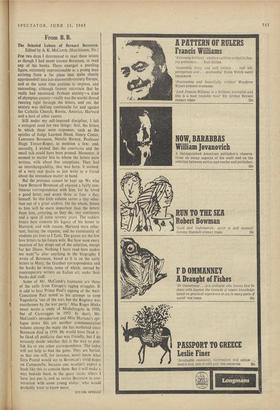From B. B.
FOR two days I determined to read these letters as though I had never known Berenson, or read any of his books. There emerged a puzzling figure, extremely impressionable as a young man arriving from a far place (not quite clearly apprehended) into late-nineteenth-century Europe, and at the same time anxious to impress, and succeeding; although forever uncertain that he really had succeeded. Pcrhaps anxiety—a kind of Olympian anxiety—really was the scarlet thread running right through the letters, and yet, the anxiety was shifting continually for and against the Catholic Church, Russia, America, Harvard and a host of other causes.
Still under my self-imposed discipline, I felt a stringent need for two things: first, the letters to which these were responses, such as the epistles of Judge Learned Hand, Henry Coster, Lawrence Berenson, Natalie Barney, Professor Hugh Trevor-Roper, to mention a few; and, secondly, I wished that the courtesies and the small talk could have been pruned. Moreover, it seemed to matter less to whom the letters were written, with about five exceptions. They had an interchangeability, that was born, it seemed, of a very real desire to just write to a friend about the immediate matter in hand.
But the pretence cannot be kept up. We who knew Bernard Berenson all enjoyed a fairly con- tinuous correspondence with him, for he loved a good letter, and wrote three or four a day, himself. So this little volume seems a tiny selec- tion out of a great archive. On the whole, letters to him will be more important than the letters from him, covering, as they do, two continents and a span of some seventy years. The saddest letters here concern his legacy of his house to Harvard, and with reason. Harvard were reluc- tant, fearing the expense, and no community of students yet lives at I Tatti. The gayest are the few love letters to his future wife. But how soon every mention of her drops out of the selection, except for her illness. Nothing I have read here makes me want to alter anything in the biography I wrote of Berenson, based as it is on the early letters to Mary, the Gardner correspondence and the books he wrote, some of which, unread by contemporary writers on Italian art, make their books dull stuff.
Some of Mr. McComb's footnotes are those of the exile from Europe's raging struggles. It is odd to hear Prince Paul's signing of the Anti- Comintern Pact noted as his attempt to keep Yugoslavia 'out of the war, but the Regency was overthrown by the war party.' Also Roger Hinks never wrote a study of Michelangelo in 1930, but of Caravaggio in 1953. In short, Mr.
McComb's introduction and Miss Mariano's epi- logue make this yet another commemorative volume among the many she has mothered since Berenson died in 1959. He would have liked it:
he liked all publicity that was friendly, but I do seriously doubt whether this is the way to pub- lish his or any other correspondence. The index will not help to find the gems. They are buried, so that one will, for instance, never know what Ezra Pound would say to Berenson's vivid pages on Campanella, because one wouldn't expect a book like this to contain them. But it will make a
nice bedside book in the spare room, where I have just put it, and so revive Berenson in con- versation with some young visitor, who would probably want to know more.
SYL VIA SPRIGGE


































 Previous page
Previous page